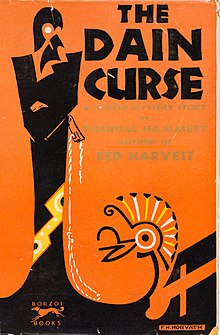Pulp magazines were inexpensive fiction magazines that were published from 1896 to the late 1950s. The term "pulp" derives from the cheap wood pulp paper on which the magazines were printed. In contrast, magazines printed on higher-quality paper were called "glossies" or "slicks". The typical pulp magazine had 128 pages; it was 7 inches (18 cm) wide by 10 inches (25 cm) high, and 0.5 inches (1.3 cm) thick, with ragged, untrimmed edges. Pulps were the successors to the penny dreadfuls, dime novels, and short-fiction magazines of the 19th century.
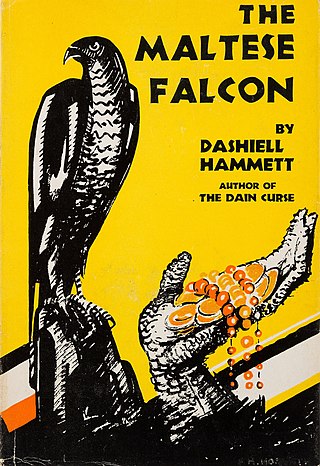
The Maltese Falcon is a 1930 detective novel by American writer Dashiell Hammett, originally serialized in the magazine Black Mask beginning with the September 1929 issue. The story is told entirely in external third-person narrative; there is no description whatsoever of any character's thoughts or feelings, only what they say and do, and how they look. The novel has been adapted several times for the cinema.

Samuel Dashiell Hammett was an American writer of hard-boiled detective novels and short stories. He was also a screenwriter and political activist. Among the characters he created are Sam Spade, Nick and Nora Charles, The Continental Op and the comic strip character Secret Agent X-9.

James Harrison Coburn III was an American film and television actor who was featured in more than 70 films, largely action roles, and made 100 television appearances during a 45-year career.
This article contains information about the literary events and publications of 1929.
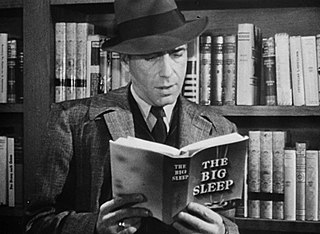
Philip Marlowe is a fictional character created by Raymond Chandler who was characteristic of the hardboiled crime fiction genre. The genre originated in the 1920s, notably in Black Mask magazine, in which Dashiell Hammett's The Continental Op and Sam Spade first appeared. Marlowe first appeared under that name in The Big Sleep, published in 1939. Chandler's early short stories, published in pulp magazines such as Black Mask and Dime Detective, featured similar characters with names like "Carmady" and "John Dalmas", starting in 1933.

Black Mask was a pulp magazine first published in April 1920 by the journalist H. L. Mencken and the drama critic George Jean Nathan. It is most well-known today for launching the hardboiled crime subgenre of mystery fiction, publishing now-classic works by Dashiell Hammett, Raymond Chandler, Erle Stanley Gardner, Cornell Woolrich, Paul Cain, Carroll John Daly, and others.
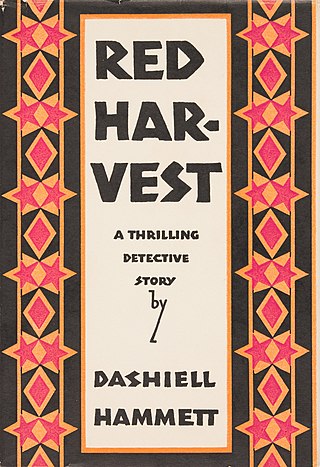
Red Harvest (1929) is a novel by American writer Dashiell Hammett. The story is narrated by the Continental Op, a frequent character in Hammett's fiction, much of which is drawn from his own experiences as an operative of the Pinkerton Detective Agency. The plot follows the Op's investigation of several murders amid a labor dispute in a corrupt Montana mining town. Some of the novel was inspired by the Anaconda Road massacre, a 1920 labor dispute in the mining town of Butte, Montana.
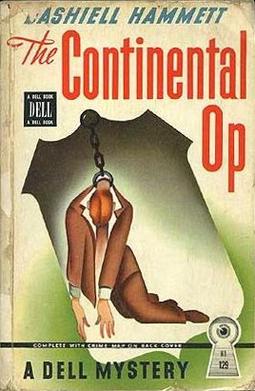
The Continental Op is a fictional character created by Dashiell Hammett. He is a private investigator employed as an operative of the Continental Detective Agency's San Francisco office. The stories are all told in the first person and his name is never given.

The Glass Key is a novel by American writer Dashiell Hammett. First published as a serial in Black Mask magazine in 1930, it then was collected in 1931. It tells the story of a gambler and racketeer, Ned Beaumont, whose devotion to Paul Madvig, a crooked political boss, leads him to investigate the murder of a local senator's son as a potential gang war brews. Hammett dedicated the novel to his onetime lover Nell Martin.

Alice, Sweet Alice is a 1976 American psychological slasher film co-written and directed by Alfred Sole, and starring Linda Miller, Paula Sheppard, and Brooke Shields in her film debut. Set in 1961 New Jersey, the film focuses on a troubled adolescent girl who becomes a suspect in the brutal murder of her younger sister at her First Communion, as well as in a series of unsolved stabbings that follow.
John Maddox Roberts is an American author of science fiction, fantasy, and historical fiction including the SPQR series and Hannibal's Children.
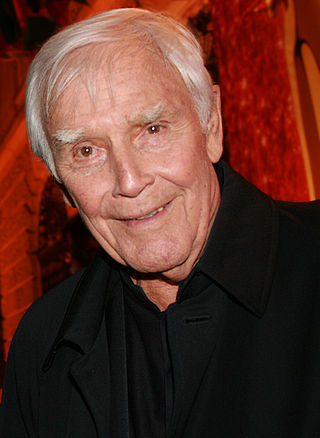
Joachim "Blacky" Fuchsberger was a German actor and television host, best known to a wide German-speaking audience as one of the recurring actors in various Edgar Wallace movies. In the English-speaking world, he was sometimes credited as Akim Berg or Berger.
Michael Raymond Donald Ashley is a British bibliographer, author and editor of science fiction, mystery, and fantasy.

Fiona Christianne Dourif is an American actress and producer. She is known for her role as Bart Curlish in BBC America's Dirk Gently's Holistic Detective Agency and as the young Diane Jones in Dustin Lance Black's When We Rise. She has appeared in Showtime's Shameless, and in a recurring role on NBC's The Blacklist, and starred as Nica Pierce in the 2013 horror film Curse of Chucky, its sequel Cult of Chucky, and the television series Chucky, all of which are part of the Child's Play franchise; she appears in these works alongside her father, Brad Dourif, who portrays the series' main antagonist, Chucky; in Chucky, Dourif herself also portrays her father's character Chucky, both as his younger self, and as his character possessing hers. In 2018, she was cast as Good Leader Tavis in the USA Network series The Purge.
The original historic Knights Templar were a Christian military order, the Order of the Poor Fellow Soldiers of Christ and of the Temple of Solomon, that existed from the 12th to 14th centuries to provide warriors in the Crusades. These men were famous in the high and late Middle Ages, but the Order was disbanded very suddenly by King Philip IV of France, who took action against the Templars in order to avoid repaying his own financial debts. He accused them of heresy, ordered the arrest of all Templars within his realm, put the Order under trial and many of them burned at the stake. The dramatic and rapid end of the Order led to many stories and legends developing about them over the following centuries. The Order and its members increasingly appear in modern fiction, though most of these references portray the medieval organization inaccurately.
Henry Soskin, better known as Henry Lincoln, was a British author, television presenter, scriptwriter, and actor. He co-wrote three Doctor Who multi-part serials in the 1960s, and — starting in the 1970s — inspired three Chronicle BBC Two documentaries on the alleged mysteries surrounding the French village of Rennes-le-Château — and, from the 1980s, co-authored and authored a series of books of which The Holy Blood and the Holy Grail was the most popular, becoming the inspiration for Dan Brown's 2003 best-selling novel, The Da Vinci Code. He was the last living person to have written for Doctor Who in the 1960s.
Raoul Whitfield was an American writer of adventure, aviation, and hardboiled crime fiction. During his writing career, from the mid-1920s to the mid-1930s, Whitfield published over 300 short stories and serials in pulp magazines, as well as nine books, including Green Ice (1930) and Death in a Bowl (1931). For his novels and contributions to the Black Mask, Whitfield is considered one of the original members of the hard-boiled school of American detective fiction and has been referred as "the Black Mask's forgotten man".
